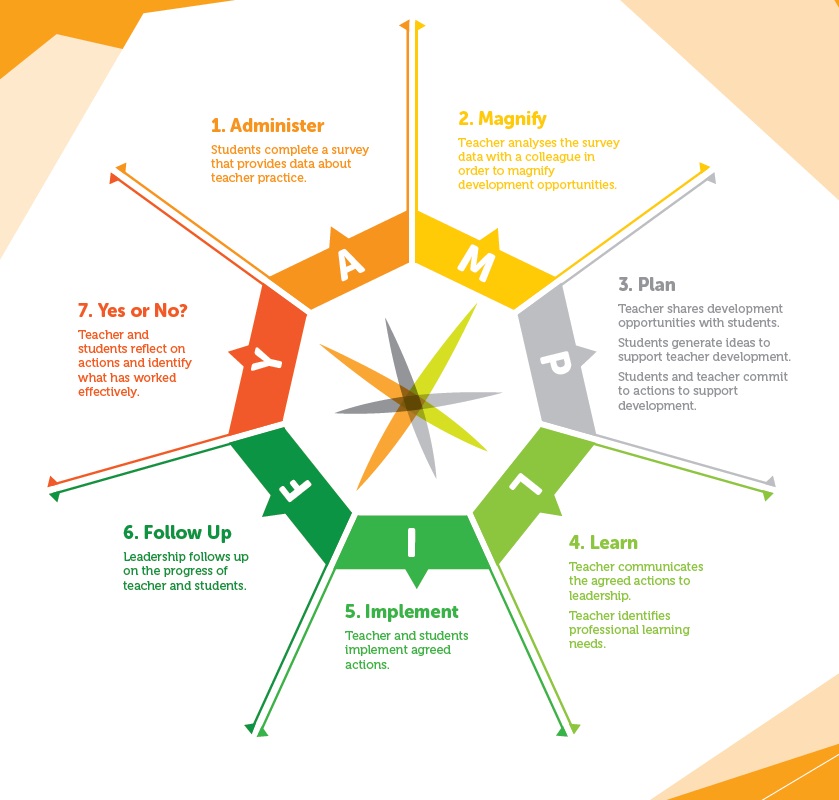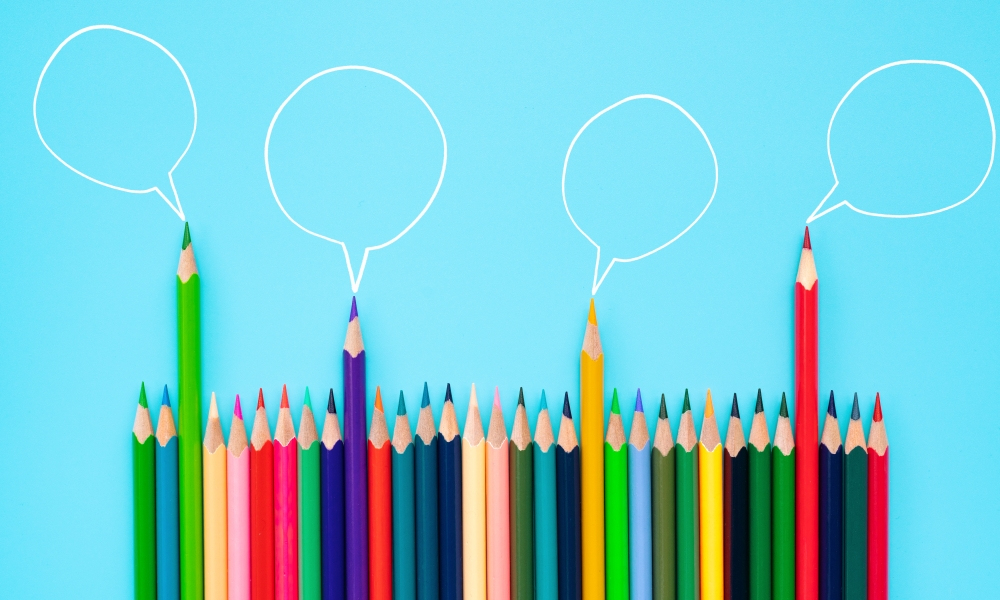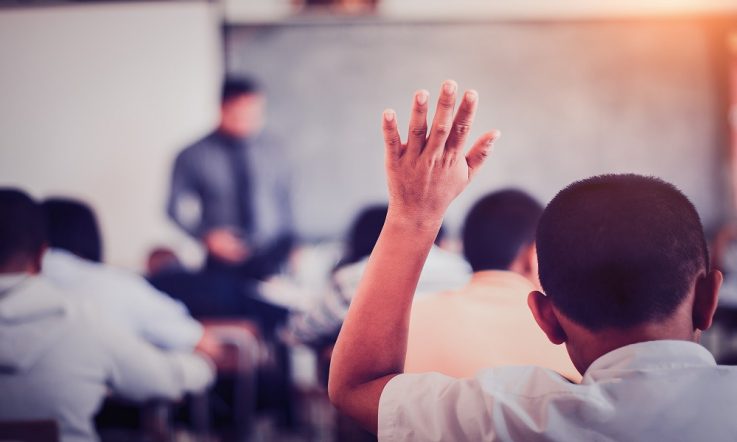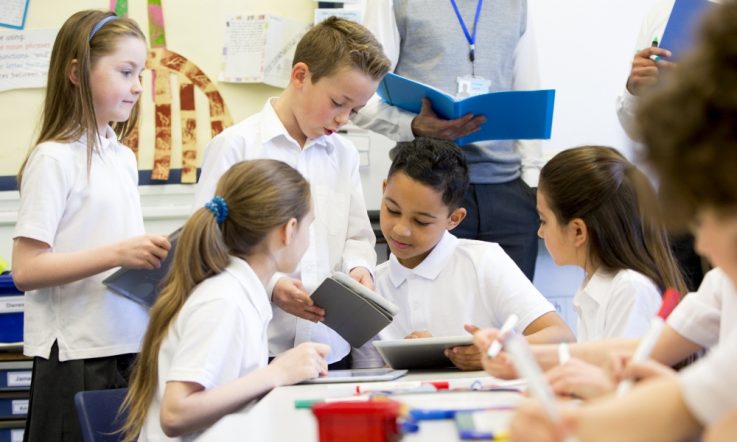This podcast from Teacher is supported by Bank First the customer owned bank proudly supporting the education community since 1972.
Hello and thanks for downloading this School Improvement podcast from Teacher, I'm Rebecca Vukovic.
Scoresby Secondary College in Melbourne's east is on a mission to improve instructional practice by embedding student voice in the school's improvement cycle. To do this, they're using the Scoresby Secondary College AMPLIFY model, which are seven interrelated steps which synthesise a range of student voice and agency literature, as well as research on reflective practice and leadership. The goals of the model are simple: to support teachers, students and leaders to work collaboratively with the full range of student perspectives; and, to clearly define what collaborating with students for improvement-related processes looks like. For today's podcast, I headed out to the school to sit down with Murray Cronin, Head of Curriculum and Pedagogy. We discuss how the school has engaged students in decision making and improvement-related processes, and the impact that student voice has had on school culture. Murray also goes into quite a lot of detail about the AMPLIFY model and how they're going to further develop it in 2020 and beyond. Let's dive in.
Rebecca Vukovic: Murray Cronin, thanks for joining Teacher magazine.
Murray Cronin: No problem, thank you for having me.
RV: Could you start off by telling me a little bit about Scoresby Secondary College and its context?
MC: So Scoresby is a Year 7-12 government school and we're located in the suburb of Scoresby in Melbourne's eastern suburbs. We have about 300 students and this is rapidly rising. So this rise is following a lot of our recent academic success. So last year, we were identified as having the highest growth in VCE [the Victorian Certificate of Education], and this year, we essentially have doubled the number of students achieving high growth in NAPLAN … when we compare this years' to 2015/2016. As of today, almost 40 per cent of our students are achieving high growth between [Year] 7 and 9 in reading, writing, grammar, punctuation and numeracy.
So it's difficult to pinpoint exactly why the school has had such a transformation, but as a community we really think there's a few things that have contributed to this. Firstly our vision to be the college of choice – it started when we had our Executive Principal Gail Major appointed a number of years ago. And this vision really runs quite consistently through our Strategic Leadership Team, our Teaching and Learning Team, our Student Representative Council. We also believe that our college's high expectations have contributed to this, so the belief that all students can be successful.
And we also have really strong partnerships with local businesses, local industry and tertiary providers. This is where, I suppose, our view that students' voice is really integral to their education has been very significant. What we've really been concentrating on recently is how we can engage our students with these partners as well. So, some of the things that we've done is teamed up with one of our partners, Thermo Fisher, and they have actually been giving students roles of real value. So some tasks that they can complete and present back to them. Two examples: so we've got our annual symposium which is a part of our English curriculum. And Thermo Fisher asked our students, well how can we make the world healthier, cleaner and safer? So the students formed political parties and they presented their views in the form of political campaigns, complete with persuasive slogans, speeches, posters, videos, and then people voted on what party they thought was the most persuasive. And recently our students were asked to design a water bottle logo which will be used at one of their events as well. As I said before, we can't attribute it down to one thing but, yeah, there's a number of things that we think are supporting our school to have this transformation.
RV: Fantastic. And I want to rewind a little bit because, since 2018, I understand that the school has advanced its efforts to meaningfully engage students in decision making and improvement-related processes. Why did you decide to do this? Why was it a priority?
MC: Well, we have several policy developments that really drive what schools are doing within Victoria and outside of Victoria. So a lot of policy underpinned our work. So at Scoresby we used what's called the Framework for Improving Student Outcomes (or FISO) to reflect on where we were at as a school. So it's similar to the National School Improvement Tool, which a lot of people outside of Victoria might be familiar with. And FISO helps schools to reflect on where they're at with current practices and what improved practice would look like.
For our school, improved practice in the student voice, agency and leadership space, was pretty clear. So on this continuum we could see that if we could give all our students some agency in how their teachers teach, that would be what you could describe as the next step for us. So to achieve this, we really needed to have some structures and processes in place that would allow teachers to engage with and respond to all students – so I really want to emphasise that, all students. And students would also need to have the agency to work collaboratively with their teachers in order to improve instructional practice.
From a leadership point of view, we also needed to be able to demonstrate improvement and the impact of these structures and processes.
RV: So by mid-2018, the school had developed a highly structured cycle of inquiry, called the Scoresby Secondary College AMPLIFY model. Could you tell me a little bit about this model?
MC: Well FISO helped us to establish our vision, so with that firmly laid out in front, we started to research, well what makes effective reflection? And we really wanted to know this because, quite simply, it's reflection that lays the foundation for teacher improvement.
So we needed to know, well what makes reflective practice effective? And it soon became clear that effective teacher reflection, its grounded in day-to-day professional practice, so the teaching and the learning, where teachers can look back on what they've done, but they can also look at it ‘in the moment', so that idea of reflecting on or reflecting in. It also became clear that re flection requires teachers to be able to see themselves through their eyes or through their students' eyes or a colleague's eyes. And we also discovered – probably most importantly – that reflection needs to be a clear process, and it needs to begin with some data, and it needs to be supported through collaboration.
So for us, this literature really emphasised that effective teacher reflection needs to be systematic, it needs to be recursive, collaborative, improvement focused, and we should be able to measure the impacts of it.
So then we turned out attention to what best practice was in relation to student voice and agency. The literature made really clear that, the very least, students should have a voice. They need to be able to speak up about their learning and they also need to be heard. So, if we're just using students as a data source it can actually be detrimental. So we wanted to make sure we're moving beyond students as just data sources.
We also wanted to have students supporting teachers in the improvement process and we learnt that students can actually contribute to this decision making – and this is where the agency comes in. So through exploring that best practice, we discovered that, you know, not only what these things were but why they were so important. But we actually didn't find out how we could do it, so it really became a situation where we had to start to develop the how. So we knew what, we knew why we should do it but the how was a bit vague.
We did have a good criteria to go by. So our criteria was that, whatever we do needs to be based on all this best practice, all this research. And we wanted to make sure that we were engaging all students, not just some. And we wanted to make sure that the students had some agency and that they were supported through a process with the teacher to improve instructional practice.
So that's where our model came from and then it was developed. It's called AMPLIFY because that is a direct reference to a department document in Victoria called AMPLIFY which is a practice guide around student voice, agency and leadership. And we wanted to call our model that because it's important to, not only align ourselves, but to make reference to these broader and larger, more systematic efforts going on.
Coming up: Murray Cronin drills down into how staff implemented the AMPLIFY model and discusses what they learned about student voice and its impact on school culture. But first, here's a quick message from our sponsor.
You're listening to a podcast from Teacher magazine, supported by Bank First. Bank First is a customer owned bank, committed to supporting the financial wellbeing of the education community since 1972. Visit bankfirst.com.au to find out how they can help you reach your financial goals.
RV: So Murray I'd like to drill down now to what you actually did, so could you tell me about the process?
MC: Well AMPLIFY is an acronym, it is seven interrelated steps and as we move through the steps we see students using their voice, being heard and having increasing agency over how they're taught. And what I'll talk about now is taken directly from our AMPLIFY handbook, which includes a range of resources and information to support people to be consistent in how they're implementing the process.
So the first part of the process is A for administer. And here we see students completing a student perception survey. Last year we used the ACER Student Teacher Questionnaire [Student Perceptions of Teaching Questionnaire SPTQ]. We began using that, we found that it aligned very well to our school's instructional model. It also aligned very well to the AITSL standards. And essentially it's an online survey that the students could complete in about 10 minutes. There were by memory about 60-65 questions and it's very simple in that it's five response options, so the five Likert scale.
So teachers administer the survey and then the second part of the process is M for magnify. So we receive the data, each individual teacher gets their own data, it's not distributed to anyone else. And the teacher sits down and they magnify the data and they hone in on one to three things that stands out to them. So we start off by asking, what can be celebrated? And what can be improved to enhance learning? So these questions support the positive acknowledgement of what people are doing well and the idea that this is all about improvement.
So the next part of the process is plan, P for plan. So having identified a couple of practices from the survey that they would like to improve, the teacher then goes back to the class and says, ‘this is what you guys have said. These are some areas that I identified as being lower than other areas', because the survey data is numerical, so it's quite easy to reflect on. And this is essentially where the teacher says, ‘I've listened and now I want to give you some agency over how I teach'. So, together, the students and the teacher, they're supported to express their views further and generate ideas to support improvement. So we have a bit of a brainstorm, sticky note activity for that. Again, all the students are involved in this process. So that's really important. Throughout this planning stage, the students then will vote on, what do they think will have the most impact for them?

The Scoresby Secondary College AMPLIFY model: building practice excellence through student voice. Image supplied.
The next part of the process is L, so learn. So without pointing out the obvious, we can't see teachers changing practice unless there's learning involved. So quite often, teachers might attend professional learning and then come back and implement it. So in this part of the process, leadership will talk with the teacher and they'll identify what they want to try and do to improve and if they require any [professional] learning. What's been really interesting when we did our action research is that the teachers, they haven't required any external professional learning. And this is an interesting concept because we were hypothesising that potentially the planning part of the process is in itself a learning experience for the teacher and it really begs the question, to what extent can students be professional learning resources in schools? And that's something that's really driving my thinking at the moment … every school has got students and if we are engaging them in teacher improvement practice then it's potentially an untapped resource for schools. So, I've talked about learning.
‘I' is for implement, so having potentially if they do need it, undertaking some learning the teacher then goes back to their class and they're trying to implement these goals that they've set. This part of the process can be a quick one or it might take time, depending on what they're trying to do.
F is for follow up. This was incorporated into the model because so many professional learning programs and models are criticised for their lack of follow up. So we wanted to formally recognise that it's so important for leaders to check in and make sure that people are progressing and working towards what they want to achieve. They might potentially need further support but, so far, we haven't had to do anything extra as well.
At the end of the process we have the Y, so this is essentially Y for yes (or no). A lot of professional learning models talk about at the end, there's kind of this omit or continue stage. So we've just got ‘yes' or ‘no'. And this is where again, the teacher reflects with the kids. Is this helping? And it's a bit more anecdotal, this information, because at the end of the process we go back to A, which really is emphasising this feedback loop about continuous improvement. So we administer surveys again and we can again identify any practices that might require improvement.
RV: And Murray, throughout this process, what did you learn about student voice and how it impacts on school culture?
MC: I've referenced an action research project a few times. When we developed the model it was entirely theoretical. And, we were confident, we felt there were some pretty defensible practices within the model. But we really wanted to see if it supported students and teachers to collaboratively reflect on and improve instructional practice. So we implemented an action research project. We treated it a bit like a restaurant would do a soft opening, just a small scale trial. And we were also looking at the action research through the lens that this model might require some tweaks along the way. So we spoke with students about it, as well as teachers, and we did make some tweaks – so it looks slightly different to how it originally did. The findings from the action research were really encouraging. You can hypothesise that it does support improved instructional practice and we were able to measure changes from the changes in the survey data for teachers.
What's really interesting, as I alluded to earlier, is well, we've had these changes to teacher practice without any external or internal professional learning, as we know it. As a leader, traditionally we are presented with the responsibility of teacher improvement and we know that leaders have such an impact on teachers and the achievement of students. But something that I discovered personally is just the wealth of information and knowledge that students could generate. As I said, traditionally it's come down to individuals supporting other individuals and coming up with ideas for effective practice. But the students came up with so many and so many more than I could have come up with as an individual leader.
So it's really got me thinking about, what if we conceptualise leadership as not just the adults in the place? Because leadership is the ability to influence and if we're incorporating students in that image of leadership, all of a sudden we have every individual in the school trying to influence and change and improve. So, by tapping into students we could have a community of leaders that are supporting teachers to improve.
RV: And I'd love to hear some examples of what the students shared with you. Do you have any that you could tell me about?
MC: Yeah so I could talk about my experience with the survey when I administered it. There were some clear things that I could do to improve. And one of those things was, at the end of our instructional model we encourage teachers to refer back to the learning intention and success criteria. So it's something that I personally was always doing at the beginning and throughout the lesson, but I really wasn't getting the students to reflect on their own achievement and their own progress at the end. So my survey data presented quite low scores, I think by memory the prompt was ‘my teacher gets me to reflect on my learning at the end of the lesson', it was something like that.
So I said, ‘Well what could I do? I just keep forgetting to do it. I feel like I run out of time.' So the kids said, there were lots of ideas but the ones they voted on, ‘well why don't you, number one, set a timer for 55 minutes and that will give us the five minutes at the end to do this? And why don't you ask questions in that last five minutes at random to individual students, getting them to reflect on their learning'. So it was quite a practical thing that I could do and I didn't need to do any professional learning to tweak that practice. So it was certainly a first order change, I could do it instantly and I've been doing it since.
RV: And Murray, you're a recipient of the 2019 NGS Super Scholarship awards for your work in this area. How do you intend to use the $5000 scholarship?
MC: Well when I applied for the scholarship, some of the goals that I outlined in my application … one was to make resources to support our school and other schools to engage with their students more. … I'm actually in the planning process of at the moment. We are looking to next year establish a Student Voice, Agency and Leadership Institute at our school. And the goals of that institute will be, as I said, to support other schools through professional learning, and also to continue exploring this space. So what's really interesting about student voice and agency is that, yes, there's research and, yes, there's academic work in the space, but a lot of it requires the knowledge generated by schools, teachers and students.
So number one, we'll develop professional learning resources. At the moment we're looking at podcasts, so this is a good experience to see what it's like. And the reason for that is we want the resources to be available digitally so teachers, leaders and students can use them together. So current professional learning models require people to quite often leave their school and students aren't really included in that. So we want it to be available to anyone, anywhere, at any time. We've come up with the plan for that as well, so we're just at the moment researching, well what sort of technical requirements should we consider?
And as I said before too, the second part will be to continue exploring new avenues and contributing back to the literature. So we do a lot of consuming of it, we want to be producers of it as well and including students in that process as well.
RV: Fantastic. And so, what's next then? I know you've touched on a few things there about how you'd like to use the scholarship. But in terms of the school's priorities, what's 2020 looking like for you?
MC: It's certainly going to be busy. We are going to reflect on our practice, as always, towards the end of this year and thinking about well, what do we need to improve? What can we refine? What can we consolidate? So even our documentation around this AMPLIFY model will be looked at. Our instructional model will be looked at, and we'll start to consider how else we can engage students in either building a positive climate in the school, how can we engage them in their learning? How can we engage them more in how teachers teach? Are there any new leadership structures that we can introduce, refine? It's just constantly looking at what we're doing and thinking ‘how can we do it better?'.
That's all for this episode. If you'd like to listen to more from Teacher, you'll find us by searching ‘Teacher ACER' wherever you get your podcasts – on Apple Podcasts, SoundCloud or Spotify. And while you're there, make sure you subscribe to the channel by clicking the purple ‘Subscribe' button on Apple, the green ‘Follow' button on Spotify or the orange ‘Follow' button on SoundCloud. By subscribing, you ensure that new podcasts land in your feed as soon as they're available. You'll also get a notification straight to your device, which is really handy for making sure you never miss an episode.
You've been listening to a podcast from Teacher, supported by Bank First. Bank First has been committed to supporting the financial wellbeing of the education community since 1972.
Think about how you reflect on your practice as a leader. Do you engage students in this reflection process? Is this something that you could do more of in your school setting?
Do you meaningfully engage students in decision making and improvement-related processes at your school? How does this impact on your overall school culture?



